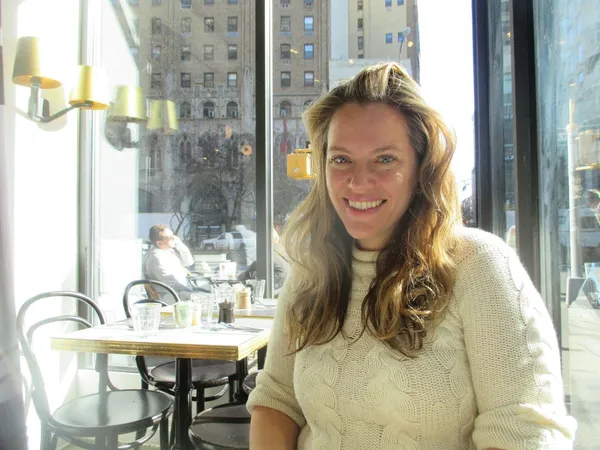 |
| Alexandra Dean on Diane Kruger in Bombshell: The Hedy Lamarr Story: "She reads Hedy's letters … I was thrilled." Photo: Anne-Katrin Titze |
On New York's Upper West Side, Alexandra Dean, the director of Bombshell: The Hedy Lamarr Story, met with me for a conversation on the movie star who was lauded in the Thirties and Forties as the most beautiful woman in the world. In her revelatory documentary, executive produced by Susan Sarandon, Regina Kulik Scully and Michael Kantor, a highlight of this year's Tribeca Film Festival, we see a person who was much more than a pretty face.
Hedy Lamarr, born Hedwig Kiesler in 1914, grew up in an assimilated Jewish family in Vienna. Her swim in the nude in Gustav Machatý's 1933 film Ecstasy (Ekstase) made even the American press notice the young actress. "She goes through her role thoroughly, her facial expressions are most expressive and the lack of dialogue on her part is not greatly missed," wrote the New York Herald Tribune. People wanted to look at her and not hear what she had to say - a curse that followed her throughout her life.
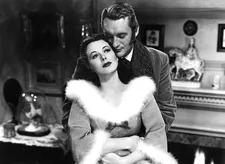 |
| Hedy Lamarr with George Sanders in Edgar G Ulmer's The Strange Woman |
Few knew how important it was, what the woman who inspired the looks of Catwoman, as well as Disney's Snow White, actually had to contribute. Dean shows us a brilliant mind who, on the side, was developing innovative technology that ended up being used by the US military during the Second World War.
As an inventor, her patented secure communication systems, via frequency hopping, not only helped defeat the Nazis, but are still in use in the present, contributing to the workings of GPS, WiFi, satellites and Bluetooth.
Her life story plays out like an adventure novel overflowing with intrigue. There is the story of how she fled from her Nazi arms-dealer husband in Austria, her scandalous swimming scene, and how she bargained with MGM studio boss Louis B Mayer who was snatching up for cheap Jewish talent, who were looking to flee Europe in the late Thirties.
Hedy Lamarr is impossible to put into a box. Her agency is as impressive as her style. The director and I start out with the world we live in today.
Anne-Katrin Titze: I saw the film at Tribeca, which was in April. We live in a slightly different world now, after Weinstein and in the middle of the avalanche that followed. Do you see the timing as a good one? Isn't it even better to have your film open now?
Alexandra Dean: It's an astonishing thing. This film I think is in some ways the backdrop to that scandal. You know, this is a woman who was given everything - brains, beauty, all the gifts. And she was playing inside a system in Hollywood that was really rigged against her, that didn't recognise her for her brains. Really kept her in her place, it didn't allow her to rise up in the ranks. And that is the backdrop to the scandal and the #MeToo moment we are seeing now. Even I look at [the film] now a bit differently.
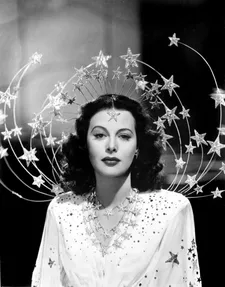 |
| Hedy Lamarr starred in Robert Z Leonard''s Ziegfeld Girl with Lana Turner and Judy Garland |
AKT: Hedy Lamarr was also a producer of her own films.
AD: That's what I love about Hedy, she didn't put up with it. Even though she was in the system which she couldn't win in, she and Bette Davis were the two actors who said, you know what? In '46, we're going to start our own system.
AKT: The Strange Woman was the film [directed by Edgar G Ulmer]?
AD: The Strange Woman was her first film. She went out in 1946 and produced the film The Strange Woman which did modestly have a success. And Janine Basinger, the film historian, teaches it in her courses as exemplary of that kind of genre.
AKT: I don't think I have seen it.
AD: It's about how - wait for it - beauty can make you evil! So Hedy wanted to talk about issues that were important to her. Obviously that's something she struggled with. She thought that looks were dangerous in some way.
AKT: "Every girl can look glamorous. All she has to do is stand still and look stupid." That's a great quote.
AD: Bless Hedy!
AKT: Yes, bless Hedy!
AD: We open the film with that quote because, first thing, it introduces the viewer to this woman's humor. She's funny because she's so smart. And you know immediately that this thing about her beauty, to which you are about to be introduced, is complicated. I'm about to show you these photographs of this woman that was considered the most beautiful woman in the world.
And I don't want you as the viewer to just fall into them, in the same trap as everybody else did when she first hit the silver screen in the Thirties and Forties. I wanted you to realize right away that there's intellect behind these photos.
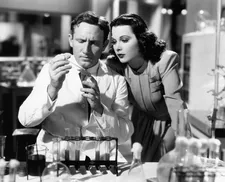 |
| Hedy Lamarr with Spencer Tracy in WS Van Dyke's I Take This Woman |
AKT: And still, the beauty is there.
AD: How can you keep it out?
AKT: Right. Why is it even an issue that someone so beautiful can have a matching intellect? Let's get straight to her inventions. GPS, WiFi, satellites and Bluetooth - What exactly did she influence? What are Hedy Lamarr's inventions?
AD: The incredible thing is, we actually do know that the United States Navy gave her patent, with her name on it and everything, to a freelance Navy engineer who then put it into various military communication systems. So directly from her frequency hopping system we had a secure way to communicate with early military surveillance drones. And with ships trying to communicate with sensors in the water that were trying to figure out if submarines were there.
These two we know were just modeled on Hedy's patent because the man who created those two inventions thanked her for it. When something like that is in the military it just migrates out from those early military patents. Because the military invents so much of our life. GPS was a military invention that used frequency hopping which is a way of keeping communication secure.
AKT: It's fascinating to see the image from Ziegfeld Girl of Hedy with the stars around her head - it's a perfect image. There she is with her inventions that are like the stars, reaching the stars.
AD: And what's funny is that her inventions, the most prominent use of her inventions is actually in something called the Milstar Satellite System - which is I think a 43 billion dollar satellite system the military uses for communication. So some of those twinkling stars you look at at night and see today are the satellites using her invention. So it's perfect.
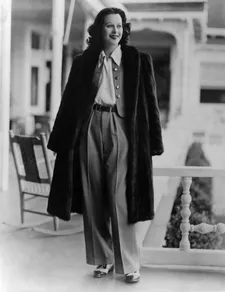 |
| On Hedy Lamarr and Louis B Mayer: "He offered her a very low budget contract, she decided that she was worth more than that and walked out." |
AKT: You have Diane Kruger as a narrator, or rather a reader.
AD: Yes, she is not a narrator. She reads Hedy's letters. I knew she had a natural interest in Hedy. I was thrilled. She was the first person I asked and she said yes. I think she does a great job. I mean there's some people who sort of complain because she has a German accent and Hedy has a Viennese accent.
AKT: Really? Who should it have been? I like Diane Kruger's reading. Louis B. Mayer was in London. Hedy Lamarr wanted to do a test for him. This is how her Hollywood career began. She was very proactive all the time?
AD: The thing about Hedy that makes you want to stand up and applaud is that when she was fleeing the Nazis, she was not in a very strong position. But even so, when she went to meet Louis B Mayer, and he offered her a very low budget contract, she decided that she was worth more than that and walked out.
AKT: Which year was that?
AD: That was 1937 in the fall. And he was scooping up all these Jewish actors and actresses leaving and he was offering them all very bad contracts. And Hedy was the one who said no thank you, I'm worth more than that.
AKT: That says a lot about him, too. I wasn't aware that he was in London scooping up talent in 1937.
AD: The way he treats her, according to [the book] Ecstasy And Me, which is an unreliable source, but in this case it sounds a lot like Hedy. Hedy tells the story that she was in this room, meeting this man, who was not speaking her language, he was speaking English. And he came up and he patted her on the behind.
AKT: Oh, there we go.
AD: And he told her that he'd seen Ecstasy and that you'd never get away with that in America. If she were to come over, she'd better behave herself.
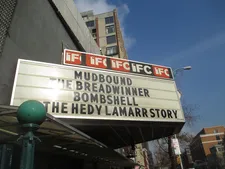 |
| Bombshell: The Hedy Lamarr Story at the IFC Center Photo: Anne-Katrin Titze |
AKT: Yuk!
AD: And that was part of why she walked out. She did not feel respected.
AKT: But then, in 1938, she stepped off the boat, changed her name and became Hedy Lamarr?
AD: That was October '37. What happened is she walked out and her agent said: "You're crazy. We don't know if London is safe. You've got to get out of here." And the agent said: "He [Mayer] is leaving tomorrow on the Normandie." And she said: "I'll get on the boat." And he said: "No you can't the tickets are sold out." And she went: "Well, I'll get on the boat in disguise." And she did!
She went on as the governess as one of the agent's other clients. He was a young musician, prodigy. He was underage. So she dressed as his caregiver and got on the boat with him. Then she got into her most beautiful outfits and paraded herself in front of Louis B Mayer and every man on the ship until he finally took notice. You know, she broke him down. And when everyone on the ship was in love with her finally, she went back to see him and then he offered her a top contract.
AKT: "My mother was like a racehorse," the son says.
AD: That was about the studio system. They were relentless.
AKT: Speed and sleeping pills.
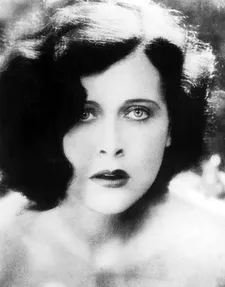 |
| Hedy Lamarr in Gustav Machatý's Ecstasy |
AD: They worked these girls, these women, from early in the morning to late at night. To make them perform the way they did, they gave them a lot of drugs. Judy Garland talks about the same thing. And Judy and Hedy were very close friends [and starred together also with Lana Turner in Ziegfeld Girl].
Robert Osborne had memories of them running into the bathroom together and popping pills and changing clothes with each other and coming out. So the studio system really got these women addicted to dangerous drugs. And they didn't know what they were at the time. Everybody was doing uppers and downers. But still, it was part of this total control over their lives.
AKT: They were the stable.
AD: That's right, they were the stable. They were the racehorses.
AKT: Howard Hughes and Hedy - they were inventing together?
AD: According to Hedy, Howard Hughes is one of her co-inventors. And the way she talks about it you believe her. Why not? It seems true. We know that they dated a couple of times in '41 and in '39, '40. There was a moment in one of her letters she says "he proposed to me." But he was proposing to all the Hollywood stars, you know.
AKT: Katharine Hepburn, Ava Gardner - and Hedy was somewhere in the mix at the time.
AD: And some part of her knew that he wasn't serious. Also she felt he was a bit like Fritz Mandl [her Austrian husband]. He liked to control the women around him, which was true. And she didn't want to be controlled again.
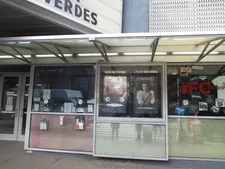 |
| Bombshell: The Hedy Lamarr Story poster at the IFC Center Photo: Anne-Katrin Titze |
AKT: Nobody seemed to have been able to really control her, as much as people wanted to. At age five she took a music box apart and put it back together?
AD: And the amazing thing is that we have that music box in the film. Later on we meet Manja, her manicurist, who had been through the camps, who had told Hedy about it. Manja was the one who had the music box because Hedy had given it to her as a gift, as their shared remembrance of this homeland that they lost.
And she gave it to her so that she can give it to her son so that they can keep passing on the Vienna that they lost. And Manja, when we did the interview, gave the music box back to Hedy's son.
Bombshell: The Hedy Lamarr Story is in cinemas in the US and will open in the UK on March 9, 2018.





















